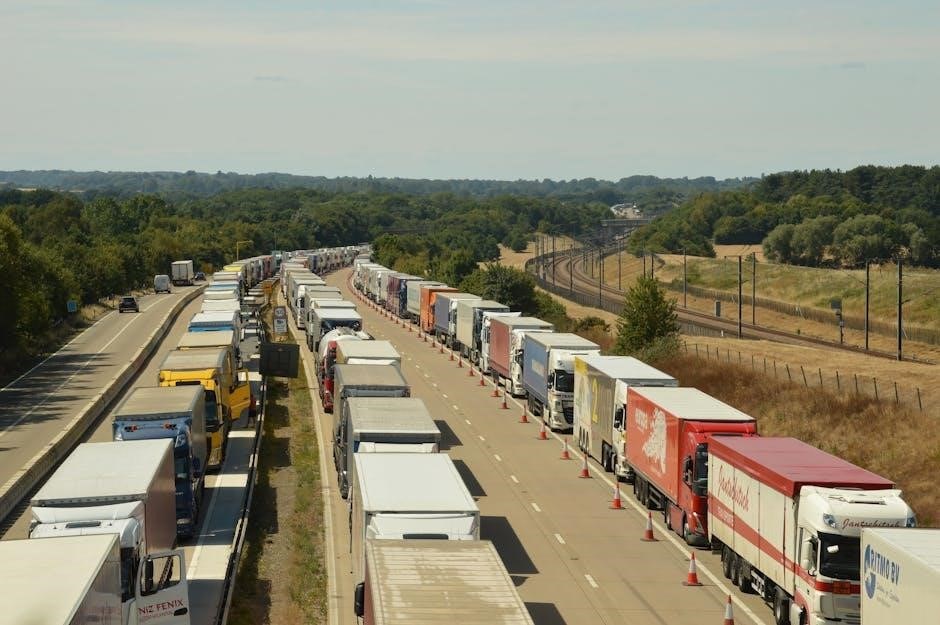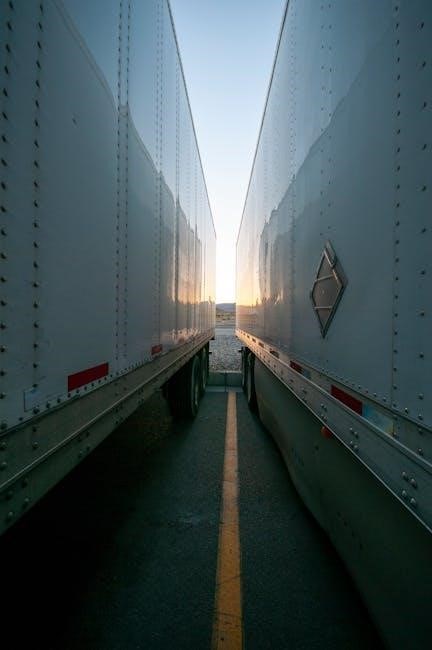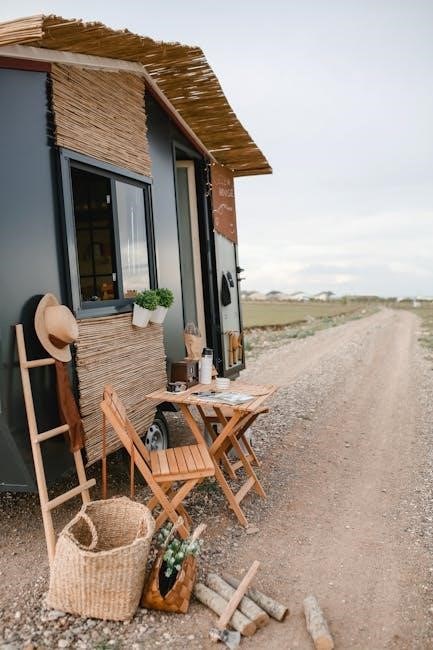Off-road trailer plans provide detailed blueprints for building sturdy‚ reliable trailers designed for rugged terrains. These plans ensure durability‚ ease of use‚ and optimal load capacity for adventures.
What Are Off-Road Trailers?
Off-road trailers are specialized vehicles designed to withstand challenging terrains like rough trails‚ mud‚ and uneven landscapes. Built for durability‚ they often feature reinforced frames‚ high ground clearance‚ and robust suspension systems. These trailers are ideal for outdoor enthusiasts‚ offering ample storage for camping gear‚ tools‚ or equipment. Unlike standard trailers‚ off-road models prioritize versatility and resilience‚ making them perfect for adventures in remote or rugged environments. Their compact yet sturdy design ensures reliability and ease of towing in harsh conditions.
Why Use Off-Road Trailers?
Off-road trailers are essential for outdoor enthusiasts seeking reliable transportation in rugged terrains. They offer durability‚ versatility‚ and ample storage for gear‚ making them ideal for camping‚ exploration‚ or remote work. Unlike standard trailers‚ off-road models are built to handle challenging conditions‚ ensuring safe and efficient load transport. Their high ground clearance and robust suspension systems enhance stability on uneven surfaces‚ while weather-resistant features protect contents from dust and moisture. This makes them a practical choice for adventures where conventional trailers fall short.
Benefits of Using Off-Road Trailer Plans
Off-road trailer plans offer numerous benefits‚ including cost savings‚ customization‚ and durability. DIY plans allow users to build trailers tailored to specific needs‚ ensuring optimal performance in rugged environments. They often include detailed instructions‚ making construction accessible even for those with limited expertise. Additionally‚ these plans promote self-sufficiency and empower users to create trailers that withstand harsh conditions‚ reducing reliance on expensive‚ mass-produced options. This approach not only enhances adventures but also provides a sense of accomplishment and control over the final product;

Key Features of Off-Road Trailers
Off-road trailers feature durable construction‚ off-road suspension systems‚ water and dust resistance‚ and high ground clearance‚ ensuring reliability and performance in challenging environments and terrains.
Durable Construction
Durable construction is essential for off-road trailers‚ ensuring they withstand harsh environments and heavy use. High-strength steel frames provide a robust base‚ while weather-resistant materials protect against corrosion and wear. Reinforced axles and sturdy welds enhance structural integrity‚ making the trailer reliable for long-term use. Proper construction techniques‚ as outlined in detailed plans‚ ensure the trailer can handle heavy loads and rough terrains without compromising safety or performance.
Off-Road Suspension Systems
Off-road suspension systems are designed to handle the rigors of uneven terrains‚ providing stability and control. These systems feature heavy-duty components‚ such as coil springs or leaf springs‚ to absorb shocks and distribute weight evenly. Properly engineered suspensions ensure smooth towing and protect cargo from damage. Many plans incorporate adjustable systems to accommodate varying loads and terrain conditions‚ enhancing both performance and safety. A well-designed suspension system is crucial for reliable off-road performance‚ making it a key focus in trailer construction plans.
Water and Dust Resistance

Water and dust resistance are critical for off-road trailers‚ ensuring durability in harsh environments. Plans often include sealing compartments‚ waterproof fabrics‚ and protective coatings to prevent moisture and dust ingress. This enhances electrical and mechanical components’ longevity‚ reducing corrosion and malfunction risks. Properly implemented‚ these features maintain trailer functionality and cargo integrity‚ even in extreme conditions. Regular maintenance‚ such as inspecting seals and coatings‚ is essential to uphold these protective measures and ensure reliability on rugged adventures.
High Ground Clearance
High ground clearance is a vital feature of off-road trailers‚ enabling them to navigate rough terrain without damage. It allows the trailer to clear obstacles like rocks‚ logs‚ and uneven surfaces‚ reducing the risk of underside damage. This design ensures stability on inclines and declines‚ making it ideal for challenging off-road conditions. Trailer plans often specify raised frames or specialized axle setups to achieve optimal clearance‚ enhancing both performance and durability in demanding environments.

Materials Needed for Building an Off-Road Trailer
Steel frames and axles provide durability‚ while heavy-duty tires ensure traction. Weather-resistant fabrics protect against elements‚ and electrical/plumbing components add functionality for off-grid adventures.
Steel Frame and Axles
The foundation of a durable off-road trailer lies in its steel frame and axles. High-strength steel ensures resilience against rough terrains‚ while galvanized or powder-coated frames resist corrosion. Axles are designed to withstand heavy loads and stress‚ with options like solid or independent suspension systems. Properly constructed steel frames and axles are crucial for stability‚ load distribution‚ and long-term reliability‚ ensuring your trailer can handle extreme off-road conditions safely and efficiently. Regular maintenance‚ such as lubrication and alignment checks‚ is essential to extend their lifespan.
Heavy-Duty Tires
Heavy-duty tires are essential for off-road trailers‚ providing the necessary traction and durability for rugged terrains. These tires feature aggressive tread patterns and reinforced sidewalls to handle rough surfaces‚ heavy loads‚ and varying weather conditions. Proper tire inflation and regular maintenance are crucial to ensure reliability and safety. Durable materials and robust construction make these tires ideal for off-road adventures‚ offering both stability and performance. Selecting the right tire size and type is vital to match the trailer’s capacity and intended use‚ ensuring optimal functionality in challenging environments.
Weather-Resistant Fabrics
Weather-resistant fabrics are crucial for off-road trailers to protect against harsh outdoor conditions. These materials‚ such as canvas‚ vinyl‚ or rip-stop nylon‚ are designed to withstand rain‚ UV exposure‚ and dust. They often feature waterproof coatings‚ tight weaves‚ or sealed seams to prevent water ingress. Durable and lightweight‚ these fabrics ensure the trailer’s interior remains dry and secure. UV resistance is also key‚ preventing fading and degradation over time. Properly selected fabrics enhance the trailer’s longevity and reliability in challenging environments‚ making them a vital component of off-road trailer construction.
Electrical and Plumbing Components
Electrical and plumbing components are essential for off-road trailers‚ ensuring functionality and comfort. These systems include wiring‚ LED lights‚ water tanks‚ pumps‚ and RV-grade hoses. Weather-resistant materials and sealed connections protect against moisture and dust. Solar panels and battery systems often supplement electrical needs‚ providing reliable power in remote areas; Proper installation and maintenance are critical to avoid leaks or electrical failures. These components enhance the trailer’s livability and durability‚ making them vital for off-grid adventures and long-term reliability in harsh environments.

Safety Considerations
Safety considerations are crucial for off-road trailers‚ ensuring secure towing‚ proper load distribution‚ reliable braking systems‚ and emergency preparedness to prevent accidents and enhance overall safety.
Towing Safety Tips
Towing safety is paramount. Always ensure your vehicle is rated for the trailer’s weight‚ use appropriate hitch setups‚ and maintain proper tire pressure. Keep a safe distance‚ avoid sudden maneuvers‚ and never exceed speed limits. Regularly inspect the trailer’s brakes and lighting systems to ensure functionality. Additionally‚ distribute the load evenly to prevent swaying and maintain control on both paved and off-road terrains. Stay alert and prepared for emergencies by carrying essential tools and a first-aid kit.
Braking Systems
Reliable braking systems are essential for off-road trailers to ensure safe and controlled stops‚ especially on uneven terrain. Electric over hydraulic brakes or air brake systems are recommended for their durability and performance. Properly installed and maintained brakes prevent skidding and loss of control. Always test brakes before towing and ensure they are synchronized with your vehicle’s braking system. Regular inspection of brake pads‚ rotors‚ and fluid levels is crucial. A well-functioning braking system enhances safety and reduces the risk of accidents during off-road adventures.
Load Distribution
Proper load distribution is critical for off-road trailer stability and safety. Ensure weight is evenly spread to avoid swaying or loss of control. Heavy items should be placed near the trailer’s axle‚ while lighter items go toward the front. Secure all cargo with sturdy straps or tie-downs to prevent shifting during transit. Improper distribution can lead to trailer instability‚ especially on uneven terrain. Always check the trailer’s axle rating and follow the recommended weight limits to maintain optimal performance and safety during off-road adventures.
Emergency Kits
A well-stocked emergency kit is essential for off-road trailer adventures. Include a first aid kit‚ flashlight‚ jumper cables‚ fire extinguisher‚ and basic toolkit. Add water‚ non-perishable snacks‚ and a portable phone charger. A shovel and traction mats can aid in sandy or muddy situations. Ensure the kit is easily accessible and checked regularly. Customize it based on your travel plans and potential hazards. A comprehensive emergency kit enhances safety and preparedness‚ helping you tackle unexpected challenges while exploring rugged terrains with your off-road trailer.

Legal Requirements for Off-Road Trailers
Off-road trailers must comply with local regulations‚ including size and weight limits‚ lighting‚ and registration. Ensure proper insurance and documentation for legal operation and safety standards.
Size and Weight Regulations
Off-road trailers must adhere to size and weight regulations to ensure safety and legal compliance. Check local and state laws for maximum allowable dimensions and weight limits. Gross Vehicle Weight Rating (GVWR) and axle load capacities are critical factors. Exceeding these limits can lead to penalties and safety hazards. Always verify towing capacity and ensure your trailer’s specifications align with legal standards to avoid issues during transportation and operation. Compliance is essential for both on-road and off-road use.
Lighting and Signage
Proper lighting and signage are essential for off-road trailers to ensure visibility and safety. Trailers must be equipped with functional tail lights‚ brake lights‚ and turn signals. Reflectors and marker lights are also required to enhance visibility‚ especially in low-light conditions. Signage‚ such as reflective markers and safety decals‚ helps alert other drivers to the trailer’s presence. Ensure all lighting components are securely installed and meet local traffic regulations to avoid legal issues and potential hazards while towing.
Registration and Licensing
Registering and licensing your off-road trailer is crucial for legal compliance. Obtain a trailer identification number and ensure it is properly displayed. Annual registration renewal is typically required‚ with fees varying by state. Trailers over a certain weight may need a title. Check local DMV requirements to ensure your off-road trailer meets all regulations‚ avoiding fines or penalties. Proper documentation ensures smooth operation and avoids legal complications while towing your off-road trailer.
Insurance Requirements
Ensuring your off-road trailer is properly insured is essential for protection against accidents or damage. Liability coverage is typically mandatory‚ while collision and comprehensive insurance are optional but recommended. Off-road trailers may require specialized insurance due to their unique usage. Check with your insurer to confirm coverage for off-road activities and custom modifications. Premiums vary based on trailer value‚ usage‚ and storage conditions. Adequate insurance ensures financial security and peace of mind while towing or using your off-road trailer in challenging environments.

Choosing the Right Off-Road Trailer Plans
Selecting the right off-road trailer plans ensures durability and ease of assembly. Consider payload capacity‚ intended use‚ and customization options. Detailed instructions and reliable sources are crucial for success‚ especially for novices and experienced builders alike.
Factors to Consider
When evaluating off-road trailer plans‚ assess your needs for payload capacity‚ suspension type‚ and material durability. Consider the intended terrain and frequency of use. Ensure the plans include detailed instructions‚ measurements‚ and a parts list. Check for compatibility with your vehicle’s towing capacity and whether the design supports customization. Additionally‚ evaluate the cost of materials and tools required. Opting for plans with a proven track record or reviews can enhance reliability and ease of construction.
Where to Find Reliable Plans
Reliable off-road trailer plans can be found on reputable websites specializing in DIY projects and automotive enthusiasts. Forums‚ online retailers‚ and manufacturers often provide detailed blueprints. Verify the credibility of the source to ensure accuracy and safety standards. Many companies offer customizable plans tailored to specific needs‚ while online communities share proven designs. Purchasing plans from trusted sellers often includes customer support and updates‚ enhancing the building experience.
Free vs. Paid Plans
Free off-road trailer plans are available online but often lack detailed instructions or customization options. Paid plans offer comprehensive blueprints with precise measurements‚ materials lists‚ and step-by-step guides. Free plans are ideal for basic projects‚ while paid plans suit serious builders needing reliability and durability. Paid options typically include customer support and updates‚ ensuring a smoother building process. Choose free for simplicity or paid for professional-grade results tailored to your off-road adventures.

DIY Construction Guide
Building an off-road trailer involves gathering tools‚ following step-by-step plans‚ and assembling components carefully. Ensure all parts are durable and suitable for rugged terrain use.
Tools and Equipment Needed
Constructing an off-road trailer requires specific tools and materials. Essential tools include welding equipment‚ angle grinders‚ impact wrenches‚ and jigsaws. Heavy-duty materials like steel frames‚ axles‚ and tires are necessary. Additionally‚ you’ll need measuring tools‚ such as tape measures and levels‚ to ensure accuracy. Consumables like welding rods and paint should also be on hand. Safety gear‚ including gloves and goggles‚ is crucial. Optional items like a trailer dolly can aid in mobility during assembly. Proper organization of these tools and materials will streamline the building process.
Step-by-Step Assembly Process
Begin by gathering all materials and tools. Start with the frame assembly‚ ensuring precise welding for durability. Next‚ install the axle and suspension system‚ aligning components carefully. Attach the trailer bed‚ securing it firmly to the frame. Add flooring and side panels‚ followed by electrical wiring and lighting. Install brakes and coupler‚ then mount the wheels. Finally‚ test the trailer by towing it under controlled conditions to ensure stability and functionality. Always follow detailed plans for accuracy and safety.
Troubleshooting Common Issues
Common issues during assembly may include misalignment of the axle or frame. Check welds for strength and ensure proper torque on bolts. If brakes malfunction‚ inspect wiring connections and brake shoe alignment. For wobbling‚ verify tire pressure and suspension balance. Address water leaks by sealing gaps in the trailer bed; Consult your plans for precise measurements and solutions. Regularly inspect all components for wear and tear to prevent breakdowns during off-road use. Always test the trailer under load before extended trips.

Customization Options
Off-road trailer plans allow for extensive customization‚ including interior layouts‚ exterior modifications‚ and additional features like storage solutions‚ lighting‚ and styling to suit personal preferences and adventures;
Interior Design
Interior design for off-road trailers focuses on creating a functional and comfortable living space. Plans often include compact layouts with built-in furniture‚ storage compartments‚ and weather-resistant materials. Customization options allow for personalized touches like cabinetry‚ countertops‚ and insulation to enhance comfort during trips. Lighting‚ ventilation systems‚ and electrical outlets are also key considerations to ensure a cozy and practical interior setup for off-grid adventures.
Exterior Modifications
Exterior modifications for off-road trailers often focus on enhancing durability and functionality. Common upgrades include reinforced frames‚ protective skid plates‚ and weather-resistant coatings. Adding roof racks‚ storage compartments‚ and external cargo holders improves utility. Mudguards‚ rock sliders‚ and upgraded tires are popular for better off-road performance. Exterior lighting‚ such as LED bars‚ increases visibility in low-light conditions. These modifications ensure the trailer withstands harsh environments while maintaining a sleek‚ rugged appearance tailored for adventure and reliability.
Additional Features
Additional features in off-road trailer plans often include advanced electrical systems‚ plumbing setups‚ and storage solutions. Many designs incorporate solar panels for off-grid power and water tanks for extended trips. Customizable storage compartments and organizers help maximize space efficiency. Some plans also offer optional upgrades‚ such as external cooking stations or showers‚ enhancing comfort during adventures. These features ensure the trailer is both functional and comfortable‚ catering to diverse needs and preferences for off-road enthusiasts.

Maintenance and Repair
Regular inspections‚ lubrication of moving parts‚ and checking tire pressure are crucial. Addressing rust and worn components ensures longevity. Schedule maintenance to prevent breakdowns.
Regular Maintenance Checks
Regular maintenance checks ensure your off-road trailer remains in optimal condition. Inspect suspension systems‚ tire pressure‚ and electrical connections. Lubricate axles and hinges‚ and check for rust or wear. Ensure all bolts and screws are tightened. Examine the frame for damage and clean electrical components. Replace worn-out parts promptly. Regular greasing of moving parts prevents corrosion and friction. Check braking systems for proper function. Addressing minor issues early avoids costly repairs. Keep a maintenance log to track inspections and repairs for long-term durability and reliability.
Common Repairs
Common repairs for off-road trailers often involve addressing tire punctures‚ rust on metal frames‚ and damaged suspension components. Electrical systems may require fixing faulty lights or wiring. Brake pads and bearings also need occasional replacement due to wear. Regularly inspecting and lubricating hinges and moving parts can prevent corrosion. Addressing dents or cracks in the frame early prevents structural weakness. Replacing worn-out seals and gaskets ensures water resistance. Keep a repair kit handy for quick fixes during adventures. Regularly cleaning and protecting metal surfaces helps avoid costly rust repairs.
Upgrading Components
Upgrading your off-road trailer’s components enhances performance and durability. Replace standard tires with heavy-duty‚ off-road-specific ones for better traction. Install a high-capacity suspension system to handle rough terrains smoothly. Upgrade to a waterproof electrical system with LED lighting for reliability. Add a reinforced axle and brakes for improved stability and control. Consider integrating a roof rack or storage compartments for extra space. Enhance water and dust resistance with advanced sealing kits. Upgrading to a more efficient braking system ensures safety during extreme off-road adventures. These upgrades customize your trailer to meet specific needs and improve overall functionality.
Off-road trailer plans provide the blueprint for creating a sturdy‚ reliable companion for any adventure. With customizable designs‚ they ensure your trailer meets your unique needs. Start building today!
Final Thoughts
Off-road trailer plans offer a comprehensive guide to creating a reliable and durable trailer for rugged adventures. With customizable designs‚ these plans cater to various needs‚ ensuring safety and performance. By following detailed blueprints‚ enthusiasts can build trailers tailored to their preferences‚ enhancing off-road experiences. The ability to modify and upgrade components provides long-term satisfaction‚ making off-road trailer plans an essential resource for outdoor enthusiasts seeking freedom and reliability in their travels.
Encouragement to Start Building
Embarking on an off-road trailer project is an exciting journey that combines creativity with practicality. With comprehensive plans‚ you can transform your vision into a sturdy‚ adventure-ready trailer. Start by gathering materials and tools‚ then follow the step-by-step instructions to bring your project to life. Remember‚ patience and attention to detail are key. The satisfaction of building something with your own hands is unparalleled‚ and the freedom to customize ensures your trailer meets all your off-road needs. Dive in and enjoy the process of creating something truly unique and functional.